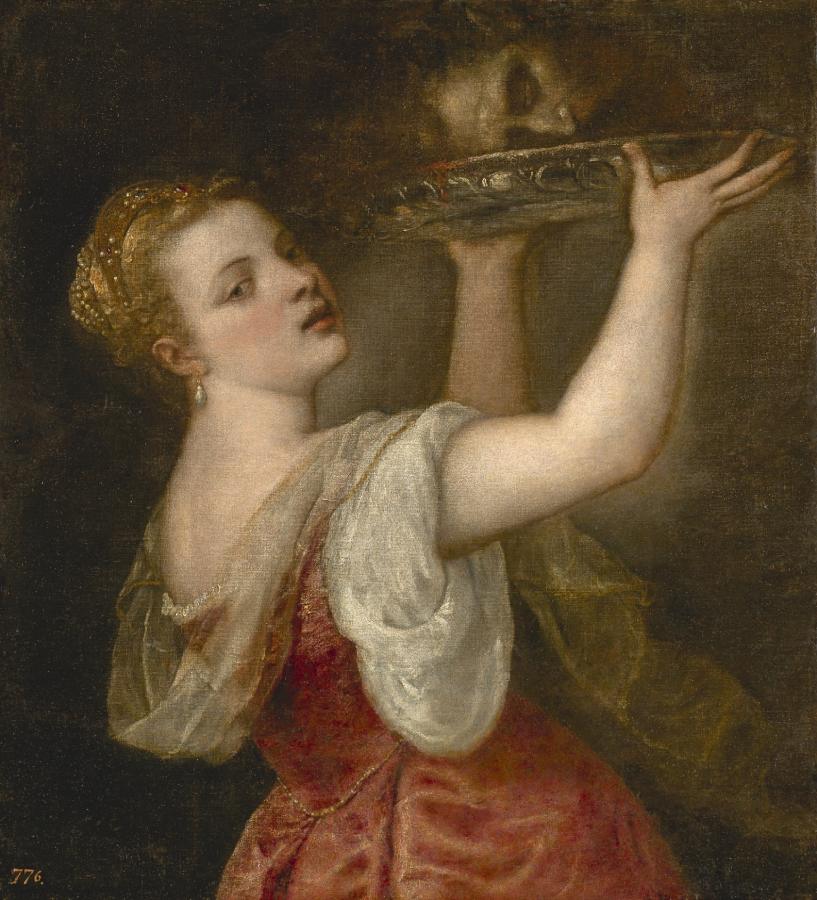Tiziano (c.1488-1576)
Salomè con la testa del Battista (Salome with the Head of John the Baptist)
c.1550
Oil on canvas, 87 x 80 cm
Museo del Prado, Madrid
Salome, an Edomite princess born of Herodias and the wife of Herod Philip I, carries the severed head of Saint John the Baptist on a tray, illustrating a Bible passage from Matthew (14:1–11) and Mark (6:22–28). Titian had already painted this story in 1516 (Galleria Doria Pamphilj, Rome), with a pyramidal composition that showed Salome bearing the saint’s head on a tray held chest high, and a servant girl. In this indoor scene with an arch in the background Titian used Salome’s suggestive clothing and the manner in which her bare arm touches the prophet’s hair to generate an eroticism that was customary in early sixteenth-century Venetian depictions of the story. Several historians have seen the Baptist’s head as a self-portrait by Titian, who would thus have launched a new subgenre -the decapitated self-portrait- later revisited by Caravaggio. In this Salome from the Museo del Prado completed three decades later, the servant has disappeared, as well as all spatial references. Holding the prophet’s head aloft, Salome is the sole protagonist. Unlike the solid pyramidal structure of the first version, the present work has a dynamism that evokes Salome’s effort to seduce Saint John with her dance. In an animated contrapposto, her body traces a diagonal emphasised by an ethereal gauze scarf that follows the same line. The composition is balanced by the vertical lines of Salome’s head and left arm. Salome focuses her seduction on the viewer, who receives her appealing gaze – a customary dramatic approach in Titian’s final works. This painting retains part of the sensuality of the first version, with the saint’s dark hair hanging off the tray to caress Salome’s pale flesh. His head resembles that of Christ in Titian’s Burial of Christ from 1557 (Museo del Prado), which reinforces the generally accepted dating of this painting to around 1550. It has often been pointed out that Titian used his daughter Lavinia as a model for this Salome, who closely resembles the supposed portrait of Lavinia in the Gemäldegalerie Alte Meister, Dresden, but this hypothesis should be discarded, given the differences between one figure and the other. X-rays reveal small differences in the position of the figure’s eyes, which were originally somewhat lower, and the placement of her arms. Her right arm is only slightly farther back than it was originally, but the left has shifted from a diagonal position to its present vertical one. Infrared reflectography shows very summary traces of preparatory drawing to mark the folds of her clothing. The success of this composition is clear in innumerable replicas and versions of very unequal quality from Titian’s bottega. One of the most outstanding is Youth with a tray of fruit/Pomona, 1555–58 (Staatliche Museen, Gemäldegalerie, Berlin), which can be understood as an allusion to marriage. There, the Baptist’s head has been replaced by fruit. In the final decades of his career, Titian also conceived a different way of representing this episode that recalls, in some ways, the version from 1516. In a version in the Koelliker Collection, Milan, the servant girl reappears, joined by a black servant, and Salome holds the tray with the saint’s head at waist level. The most important difference is the lack of any eroticism. Instead, Salome pushes her victim’s head away in repulsión (Text drawn from Falomir, M. in: Italian Masterpieces. From Spain’s Royal Court, Museo del Prado, 2014, p. 74).
